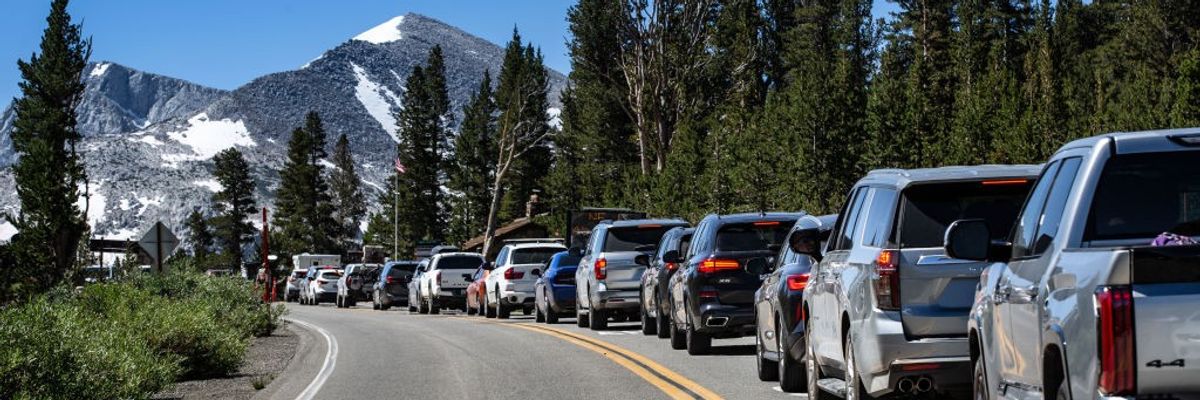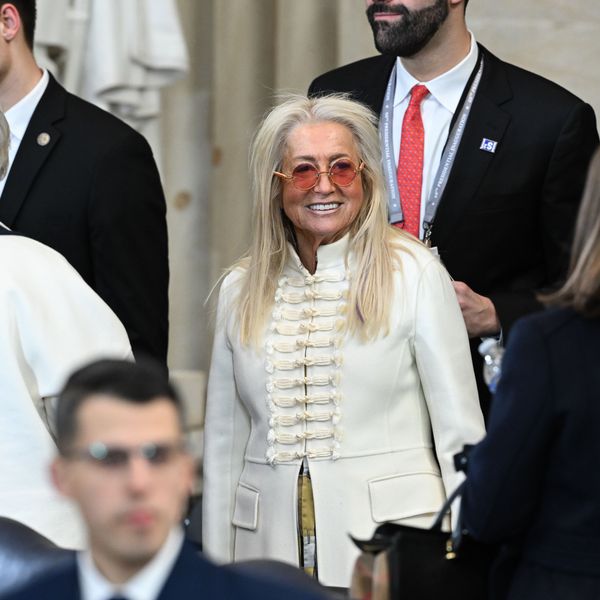
A line of cars creeps slowly to the Tioga Pass Highway 120 entrance of Yosemite National Park as viewed on August 5, 2023, just outside Yosemite National Park, California.
Is Congress Too Dysfunctional to Fund the National Parks?
The stark difference between the House and Senate versions of a funding measure have some observers speculating that the upcoming impasse may be unresolvable, leading to yet another full or partial government shutdown.
On a partisan 33-27 vote, the House Appropriations Committee has passed a spending bill that will cause the National Park Service to shed more than 1,000 staff positions as it copes with the return of record-breaking crowds.
If it stands, this 12.5% cut in operating funds would reverse Biden administration efforts to stem the overall decline in Park Service staffing. Between 2010 and 2020, the agency shrank by nearly 30%, losing around 6,000 net employees.
During this period, the ranks of permanent law enforcement rangers also fell substantially while those of seasonal law enforcement rangers deployed during peak seasons have dropped even more. Meanwhile, all these new visitors are getting into more trouble, like trying to take selfies with bison—and getting lost. In just the past six years, there has been explosive growth in park search and rescue operations, with such incidents more than tripling.
In past decades, America’s best idea was one of the few domestic programs enjoying bipartisan support.
However, the House’s impending actions are not based on any workload analyses or targeted to safeguard visitor services. In fact, some riders tacked onto the bill make the effects of overcrowding worse, such as forbidding Glacier National Park from continuing its car reservation system to reduce traffic jams in one of the many popular parks being loved to death.
This Glacier rider is the work of former Interior Secretary Ryan Zinke, who has returned to the House of Representatives after a close election to again represent Montana. Arguably, Zinke should have learned something about Park Service problems and come prepared to offer solutions—but no such luck.
Adding further insult to this impending injury are a posse of other nasty riders stapled into this funding measure, such as stripping any remaining endangered species protections from lower-48 grizzlies and gray wolves, as well as park-specific nuggets, such as
- Impeding any bans on lead ammunition or fishing tackle on federal lands;
- Reinstating mineral leases near the Boundary Waters Canoe Area Wilderness; and
- Green-lighting oil and gas development within Florida’s Big Cypress National Preserve.
Meanwhile, the Senate version of this 2024 fiscal year spending bill does not contain big cuts or any of these nasty riders. The stark difference between the House and Senate versions of this funding measure have some observers (including me) speculating that the upcoming impasse may be unresolvable, leading to yet another full or partial government shutdown when the current fiscal year funding runs out at the end of the federal fiscal year next month.
Recently, Fitch Ratings cut the U.S. debt by one notch, from AAA to AA+, partly in response to the brinksmanship in how the federal government handled the debt crisis. This appears to be a recognition by the markets of the growing governance concerns with the current Congress. It apparently has reached the point where we can no longer even manage parks.
In past decades, America’s best idea was one of the few domestic programs enjoying bipartisan support. Ironically, this former font of consensus may have morphed into the source for a new paralyzing partisan divide.
An Urgent Message From Our Co-Founder
Dear Common Dreams reader, The U.S. is on a fast track to authoritarianism like nothing I've ever seen. Meanwhile, corporate news outlets are utterly capitulating to Trump, twisting their coverage to avoid drawing his ire while lining up to stuff cash in his pockets. That's why I believe that Common Dreams is doing the best and most consequential reporting that we've ever done. Our small but mighty team is a progressive reporting powerhouse, covering the news every day that the corporate media never will. Our mission has always been simple: To inform. To inspire. And to ignite change for the common good. Now here's the key piece that I want all our readers to understand: None of this would be possible without your financial support. That's not just some fundraising cliche. It's the absolute and literal truth. We don't accept corporate advertising and never will. We don't have a paywall because we don't think people should be blocked from critical news based on their ability to pay. Everything we do is funded by the donations of readers like you. Will you donate now to help power the nonprofit, independent reporting of Common Dreams? Thank you for being a vital member of our community. Together, we can keep independent journalism alive when it’s needed most. - Craig Brown, Co-founder |
On a partisan 33-27 vote, the House Appropriations Committee has passed a spending bill that will cause the National Park Service to shed more than 1,000 staff positions as it copes with the return of record-breaking crowds.
If it stands, this 12.5% cut in operating funds would reverse Biden administration efforts to stem the overall decline in Park Service staffing. Between 2010 and 2020, the agency shrank by nearly 30%, losing around 6,000 net employees.
During this period, the ranks of permanent law enforcement rangers also fell substantially while those of seasonal law enforcement rangers deployed during peak seasons have dropped even more. Meanwhile, all these new visitors are getting into more trouble, like trying to take selfies with bison—and getting lost. In just the past six years, there has been explosive growth in park search and rescue operations, with such incidents more than tripling.
In past decades, America’s best idea was one of the few domestic programs enjoying bipartisan support.
However, the House’s impending actions are not based on any workload analyses or targeted to safeguard visitor services. In fact, some riders tacked onto the bill make the effects of overcrowding worse, such as forbidding Glacier National Park from continuing its car reservation system to reduce traffic jams in one of the many popular parks being loved to death.
This Glacier rider is the work of former Interior Secretary Ryan Zinke, who has returned to the House of Representatives after a close election to again represent Montana. Arguably, Zinke should have learned something about Park Service problems and come prepared to offer solutions—but no such luck.
Adding further insult to this impending injury are a posse of other nasty riders stapled into this funding measure, such as stripping any remaining endangered species protections from lower-48 grizzlies and gray wolves, as well as park-specific nuggets, such as
- Impeding any bans on lead ammunition or fishing tackle on federal lands;
- Reinstating mineral leases near the Boundary Waters Canoe Area Wilderness; and
- Green-lighting oil and gas development within Florida’s Big Cypress National Preserve.
Meanwhile, the Senate version of this 2024 fiscal year spending bill does not contain big cuts or any of these nasty riders. The stark difference between the House and Senate versions of this funding measure have some observers (including me) speculating that the upcoming impasse may be unresolvable, leading to yet another full or partial government shutdown when the current fiscal year funding runs out at the end of the federal fiscal year next month.
Recently, Fitch Ratings cut the U.S. debt by one notch, from AAA to AA+, partly in response to the brinksmanship in how the federal government handled the debt crisis. This appears to be a recognition by the markets of the growing governance concerns with the current Congress. It apparently has reached the point where we can no longer even manage parks.
In past decades, America’s best idea was one of the few domestic programs enjoying bipartisan support. Ironically, this former font of consensus may have morphed into the source for a new paralyzing partisan divide.
- America's Great Waters Coalition Gather on Capitol Hill to Discuss Challenges Facing America's Great Waters ›
- Raising 'All Manner of Conflict of Interest Questions,' the Only National Park Site Reopening Amid Shutdown Is in Trump Hotel ›
- At Least 74 New Poison Pill Riders in House Spending Bills This Week. Lawmakers Must Remove All of Them. ›
- Interior Announces Funding for Much-Needed Cleanup of Orphaned Oil and Gas Wells ›
- Critics Decry 'Publicity Stunt With Genuine Consequences' as Trump Deploys 'Surge' of Park Rangers to Patrol Southern Border ›
- Here's an Idea for Congress: Stop Funding War and Start Funding Peace ›
On a partisan 33-27 vote, the House Appropriations Committee has passed a spending bill that will cause the National Park Service to shed more than 1,000 staff positions as it copes with the return of record-breaking crowds.
If it stands, this 12.5% cut in operating funds would reverse Biden administration efforts to stem the overall decline in Park Service staffing. Between 2010 and 2020, the agency shrank by nearly 30%, losing around 6,000 net employees.
During this period, the ranks of permanent law enforcement rangers also fell substantially while those of seasonal law enforcement rangers deployed during peak seasons have dropped even more. Meanwhile, all these new visitors are getting into more trouble, like trying to take selfies with bison—and getting lost. In just the past six years, there has been explosive growth in park search and rescue operations, with such incidents more than tripling.
In past decades, America’s best idea was one of the few domestic programs enjoying bipartisan support.
However, the House’s impending actions are not based on any workload analyses or targeted to safeguard visitor services. In fact, some riders tacked onto the bill make the effects of overcrowding worse, such as forbidding Glacier National Park from continuing its car reservation system to reduce traffic jams in one of the many popular parks being loved to death.
This Glacier rider is the work of former Interior Secretary Ryan Zinke, who has returned to the House of Representatives after a close election to again represent Montana. Arguably, Zinke should have learned something about Park Service problems and come prepared to offer solutions—but no such luck.
Adding further insult to this impending injury are a posse of other nasty riders stapled into this funding measure, such as stripping any remaining endangered species protections from lower-48 grizzlies and gray wolves, as well as park-specific nuggets, such as
- Impeding any bans on lead ammunition or fishing tackle on federal lands;
- Reinstating mineral leases near the Boundary Waters Canoe Area Wilderness; and
- Green-lighting oil and gas development within Florida’s Big Cypress National Preserve.
Meanwhile, the Senate version of this 2024 fiscal year spending bill does not contain big cuts or any of these nasty riders. The stark difference between the House and Senate versions of this funding measure have some observers (including me) speculating that the upcoming impasse may be unresolvable, leading to yet another full or partial government shutdown when the current fiscal year funding runs out at the end of the federal fiscal year next month.
Recently, Fitch Ratings cut the U.S. debt by one notch, from AAA to AA+, partly in response to the brinksmanship in how the federal government handled the debt crisis. This appears to be a recognition by the markets of the growing governance concerns with the current Congress. It apparently has reached the point where we can no longer even manage parks.
In past decades, America’s best idea was one of the few domestic programs enjoying bipartisan support. Ironically, this former font of consensus may have morphed into the source for a new paralyzing partisan divide.
- America's Great Waters Coalition Gather on Capitol Hill to Discuss Challenges Facing America's Great Waters ›
- Raising 'All Manner of Conflict of Interest Questions,' the Only National Park Site Reopening Amid Shutdown Is in Trump Hotel ›
- At Least 74 New Poison Pill Riders in House Spending Bills This Week. Lawmakers Must Remove All of Them. ›
- Interior Announces Funding for Much-Needed Cleanup of Orphaned Oil and Gas Wells ›
- Critics Decry 'Publicity Stunt With Genuine Consequences' as Trump Deploys 'Surge' of Park Rangers to Patrol Southern Border ›
- Here's an Idea for Congress: Stop Funding War and Start Funding Peace ›

